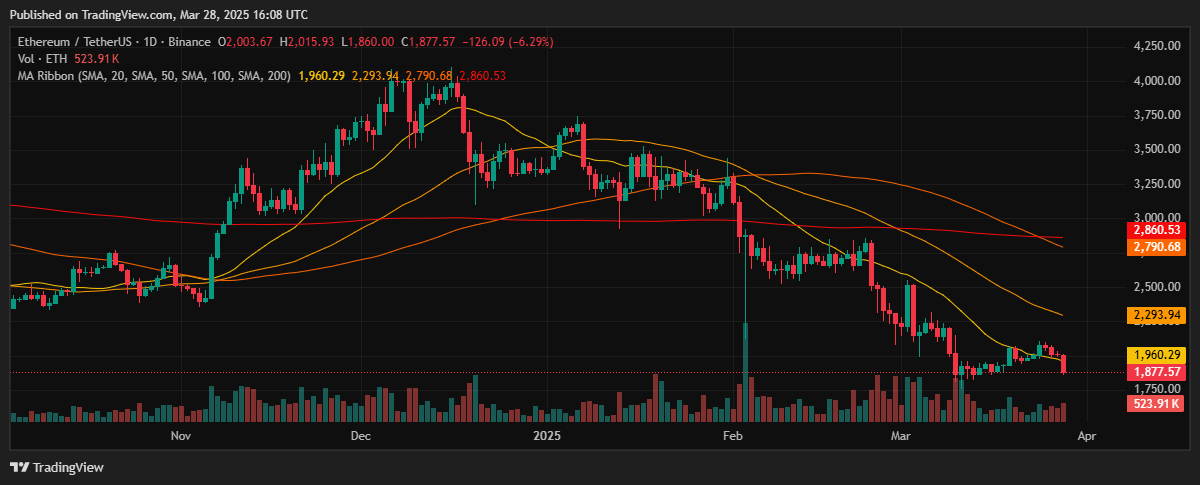
Currently, Ethereum (ETH) is trading at $1,877.20, after a 6.46% decrease in the last 24 hours. The decline suggests that sellers have recently taken control—possibly due to profit-taking or external market shocks—despite some underlying strength. Over the past 30 days, ETH has declined by 22.81%, pointing to significant medium-term bearish pressure.
Ethereum Price Analysis

The contrasting signals reveal that while short-term sentiment is negative, broader market fundamentals (including investor concerns about regulatory issues and market volatility) remain in play.
Moving Averages and Trendlines
Moving averages are instrumental in filtering out market noise and highlighting the underlying trend:
- Short-Term (4-Hour Chart): On the 4-hour timeframe, the 50-period moving average has recently begun to stabilize, even though the price is under pressure. A gradual rebound in this moving average could indicate that short-term buyers are stepping in.
- Daily Chart: On the daily chart, ETH is trading close to its 50-day moving average, which currently acts as a dynamic support level. However, the longer-term 200-day moving average is still positioned above the current price, indicating that the overall trend remains bearish. A sustained break above the 200-day MA would serve as a strong bullish signal and might mark the beginning of a trend reversal.
- Trendlines: Recent price action has seen Ethereum trading within a descending channel that has developed over the past few weeks. The upper boundary of this channel, roughly in the $1,900–$1,940 range, acts as immediate resistance. A decisive breakout above this level, particularly if supported by strong trading volume, could signal the start of a bullish phase. Conversely, if ETH fails to hold the lower boundary (around $1,850), further declines may be expected.
Key Support and Resistance Levels
Identifying support and resistance is crucial for forecasting price movements:
- Support: The primary support for Ethereum is located around $1,850–$1,870. This level has historically acted as a floor during corrections, and holding above it is essential for a potential recovery.
- Resistance: The immediate resistance is observed in the $1,900–$1,940 range. A sustained move above this resistance, particularly on high volume, could pave the way for ETH to target higher levels in the short term—potentially reaching the $2,000–$2,100 range.
Ethereum Price Prediction
Based on the technical analysis above, several potential scenarios can be considered for Ethereum’s price on March 27, 2025.
Bullish Scenario
If buying pressure strengthens and market sentiment turns positive:
- Breakout Potential: Ethereum could break above the resistance zone of $1,900–$1,940 if buyer enthusiasm overcomes the prevailing bearish pressure. In such a case, ETH might rally to reach target levels between $2,000 and $2,100.
- Catalysts: Positive catalysts such as favorable regulatory news, increased institutional adoption, or successful upgrades to the Ethereum network (e.g., improvements in the Ethereum 2.0 upgrade or enhanced scalability features) could serve as triggers for a breakout.
- Technical Confirmation: A sustained RSI above 60 and a bullish MACD crossover on the daily chart, coupled with increased trading volume, would confirm the bullish scenario.
Consolidation Scenario
If market sentiment remains uncertain:
- Range-Bound Trading: Ethereum might continue trading within a consolidation range of $1,850 to $1,940, as per Ethereum price prediction. This range-bound movement indicates that buyers and sellers are currently in equilibrium, and the market is waiting for a decisive catalyst.
- Implications: During a consolidation phase, ETH is likely to hover near its current price of $1,877.20 (based on a recent data point), with minor fluctuations. This stability can allow long-term investors to accumulate positions ahead of a potential breakout.
- Outlook: Consolidation phases often precede significant moves once a clear directional signal emerges, so traders should monitor volume and momentum indicators closely.
Bearish Scenario
If selling pressure intensifies:
- Support Breakdown: Should Ethereum fail to hold its key support at $1,850–$1,870, bearish momentum could take over, leading to a further decline.
- Price Target: In a bearish scenario, ETH might fall to the $1,800–$1,830 range or even lower if the downtrend accelerates.
- Indicators: A falling RSI below 40 and a bearish MACD crossover on the daily chart would confirm the bearish outlook.
- Outcome: Increased selling pressure, particularly if accompanied by reduced trading volume, could drive the price downward, resulting in short-term losses.
Frequently Asked Questions (FAQs)
Where can I buy Ethereum?
Ethereum is widely available on major cryptocurrency exchanges such as Binance, Coinbase, Kraken, and Bitfinex. These platforms offer secure trading environments and user-friendly interfaces for buying, selling, and holding ETH.
What technical indicators are used to predict Ethereum’s price movements?
Analysts use moving averages (50-day and 200-day), trendlines, the Relative Strength Index (RSI), and the Moving Average Convergence Divergence (MACD) to assess market momentum and identify key support and resistance levels.
What is the forecast price for Ethereum today?
For today, the forecast indicates that Ethereum will likely remain close to its current trading price of $1,877.20, unless significant market catalysts drive a breakout above $2,100 or a breakdown below $1,850.
Investment Risk Consideration
Investing in Ethereum, like any cryptocurrency, comes with inherent risks. Investors are encouraged to conduct thorough research, keep abreast of market developments, and consult with financial advisors to manage these risks effectively before making any investment decisions.













